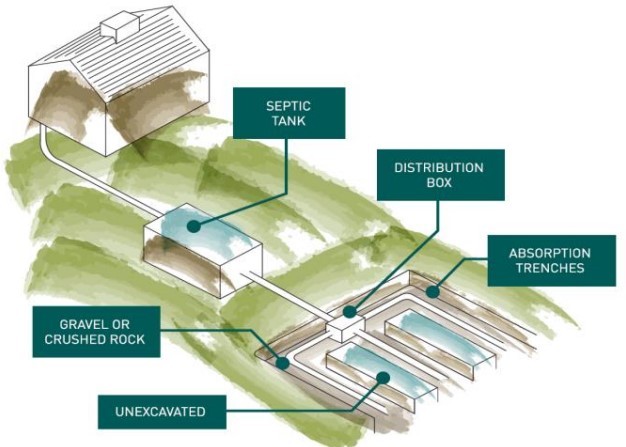How long do septic trenches last?
This question is as ambiguous as “how long is a piece of string”! The lifespan of septic trenches varies in accordance with several factors, including, placement and installation of the trench and how you maintain it after installation. Read on to find out more…
What is a septic trench?
Once effluent moves through the septic tank treatment process (or wastewater treatment plant), the resulting wastewater progresses (with the assistance of gravity, or being pumped) into the septic trench to be absorbed into the surrounding ground. The design of the septic trench allows liquid effluent to pass through small holes in the pipes into the surrounding soil.
The septic, or absorption, trench lies beneath the ground and acts as an efficient distribution system for wastewater. Not only are they highly effective in reducing odours and keeping gardens untouched by pollutants, but they also filter out any pathogens or toxins which would otherwise contaminate the environment around you.


How long will my absorption trench last & how do I know it isn’t working properly?
Blocked septic trenches are an extremely common factor causing your septic system to not work properly. Blocked trenches fail to allow the effluent from evaporating or draining away.
Absorption trenches should last for 15 to 20 years if they are well-built and correctly maintained. However, if this is not the case then the trench life can dwindle to merely 2 years! This really highlights the importance of having a licensed plumber install your septic trench and the responsibility of following the maintenance advice, which we have amassed in a handy “Dos and Don’ts” list below.
There are a few clear-cut signs that your septic trench is failing:
- The wet and soggy ground above the trench
- Unpleasant smells
- Prolific grass growth
If you discover your trench is soggy, smells or is overgrown with dense grass, then it could be exhausted so contact your plumber to check the functionality of your trench.
Septic Trench DOs and DON’Ts
DOs:
- Conduct soil tests to ascertain how long your trench should be
- Plant water-loving, shallow-rooted trees downslope from your trench
- Insert stormwater diversion systems uphill from the trench to channel runoff water away from the disposal area
- Ensure the trench is placed in a sunny area
- Regularly mow and remove grass clippings from the trench area which will encourage more effective nutrient intake.
- Check and clean your septic tank regularly otherwise untreated waste can enter the trench
- Regularly inspect the trench area for signs of failure and address any issues
DON’Ts:
- Don’t build structures in your trench area
- Do not plant trees that will shade the trench - small trees can be planted at least 5m away and large trees 20m away to avoid their roots getting into the trench pipework
- Do not disturb the diversion contour mounds
- Don’t flood the area with hoses or sprinklers
- Don’t have animals graze on the area, nor drive cars over it - fence it off so visitors are aware
- Do not put paving stones or concrete etc over the trench
- Don’t put topsoil over your trench to “soak up” overflow from your system. If there is water pooling over the trench, call a licensed plumber to check your trench.
Remember: Correct maintenance will make a septic trench last 20 years, but neglecting to do so can cause it to fail in as little as 2 years!
Stay safe: Don’t attempt to repair a septic system yourself – get a licensed plumber. Council approval is required for repairs or changes to your septic system.
Resources:
Queensland Plumbing and Wastewater Code guidelines
Factsheet: Septic System Troubleshooting